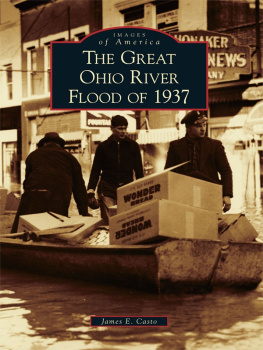Ohio River Valley Series
Rita Kohn and William Lynwood Montell
Series Editors
RIVER JORDAN
African American Urban Life
in the Ohio Valley
JOE WILLIAM TROTTER JR.
Copyright 1998 by The University Press of Kentucky
Scholarly publisher for the Commonwealth,
serving Bellarmine University, Berea College, Centre
College of Kentucky, Eastern Kentucky University,
The Filson Historical Society, Georgetown College,
Kentucky Historical Society, Kentucky State University,
Morehead State University, Murray State University,
Northern Kentucky University, Transylvania University,
University of Kentucky, University of Louisville,
and Western Kentucky University.
All rights reserved.
Editorial and Sales Offices: The University Press of Kentucky
663 South Limestone Street, Lexington, Kentucky 40508-4008
www.kentuckypress.com
Frontispiece: In River Jordan.
The Rev. George W. Wyatt of Cincinnatis Antioch Baptist Church
prepares for baptismal ceremonies in the Ohio River around World War I.
From W.B. Dabney, Cincinnatis Colored Citizens (1926)
Library of Congress Cataloging-in-Publication Data
Trotter, Joe William, 1945
River Jordan: African American urban life in the Ohio Valley /
Joe William Trotter, Jr.
p. cm.(The Ohio River Valley series)
Includes bibliographical references and index.
ISBN-10: 0-8131-2065-9 (cloth : alk. paper).ISBN-10: 0-8131-0950-7
(paper: alk. paper)
1. Afro-AmericansOhio River ValleySocial conditions. 2. City
and town lifeOhio River ValleyHistory. 3. Ohio River Valley
Social conditions. 4. Ohio River ValleyRace relations.
I. Title. II. Series.
F520.6.N4T76 1998
977'.00496073dc21 97-43458
ISBN-13: 978-0-8131-0950-3 (pbk : alk. paper)
This book is printed on acid-free recycled paper meeting
the requirements of the American National Standard
for Permanence in Paper for Printed Library Materials.
Manufactured in the United States of America.
TO AUNT VELMA TILLMAN ANDERSON
IN MEMORY OF
UNCLE MELVIN CLARENCE ANDERSON
Contents
Part 1: African Americans and the Expansion of Commercial
and Early Industrial Capitalism, 1790-1860
4. The Persistence of Racial and Class Inequality:
The Limits of Citizenship
6. African Americans,
Depression, and World War II
Figures, Maps, and Tables
Figures
In River Jordan
Maps
Tables
Series Foreword
The Ohio River Valley Series, conceived and published by the University Press of Kentucky, is an ongoing series of books that examine and illuminate the Ohio River and its tributaries, the lands drained by these streams, and the peoples who made this fertile and desirable area their place of residence, of refuge, of commerce and industry, of cultural development, and, ultimately, of engagement with American democracy. In doing this, the series builds upon an earlier project, Always a River: The Ohio River and the American Experience, which was sponsored by the National Endowment for the Humanities and the humanities councils of Illinois, Indiana, Kentucky, Ohio, Pennsylvania, and West Virginia, with a mix of private and public organizations.
The Always a River project directed widespread public attention to the place of the Ohio River in the context of the larger American story. This series expands on this significant role of the river in the growth of the American nation by presenting the varied history and folklife of the region. Each books story is told through men and women acting within their particular place and time. Each reveals the rich resources for the history of the Ohio River and of the nation afforded by records, papers, and oral stories preserved by families and institutions. Each traces the impact the river and the land have had on individuals and cultures and, conversely, the changes these individuals and cultures have wrought on the valley with the passage of years.
As a force of nation and as a waterway into the American heartland, the Ohio and its tributaries have touched us individually and collectively. This series celebrates the story of that river and its valley through multiple voices and visions.
River Jordan: African American Urban Life in the Ohio Valley reveals the impact that Pittsburgh, Cincinnati, Louisville, and Evansville had on blacks and the effects those people had on the cities themselves. Within the mainstream we witness the emergence of a distinctive black economy, culture, and political structure. Joe William Trotter draws upon traditional and new sources to bring dimension to each centers African American population and depicts how, throughout two centuries, individuals and institutions emerged from the shadows to bring diversity and vibrancy to their own and to the regions history. River Jordan presents the picture as it is, inviting us to assess the manifestations of the American story of people of color.
Rita Kohn
William Lynwood Montell
Preface
This book builds upon the recent explosion of scholarship in African American urban history. Although class, gender, and cultural issues require much more research, the existing scholarship provides the intellectual foundation for a new African American urban synthesis. Accordingly, based primarily upon existing scholarship, this book is conceived and presented as a partial contribution to a larger synthesis. The Ohio Valley is an excellent place to start because it holds great symbolic significance in African American history. It not only represented the boundary between slavery and freedom during the antebellum era, but the division between the Jim Crow South and the urban North during the industrial age. Indeed, African Americans frequently referred to the Ohio as the River Jordan because it symbolized their passage from southern bondage to the land of hope or promised land farther north.
River Jordan examines African American life in four Ohio Valley citiesPittsburgh, Cincinnati, Louisville, and Evansvillefrom the American Revolution to the mid-twentieth century. By exploring the development of black urban life in a regional context, connected by the Ohio River, this book not only aims to broaden our understanding of black life in urban America, it also addresses the overall aim of the Ohio River Valley Series, i.e., to illuminate the impact of the Ohio River in the context of the larger American story.















